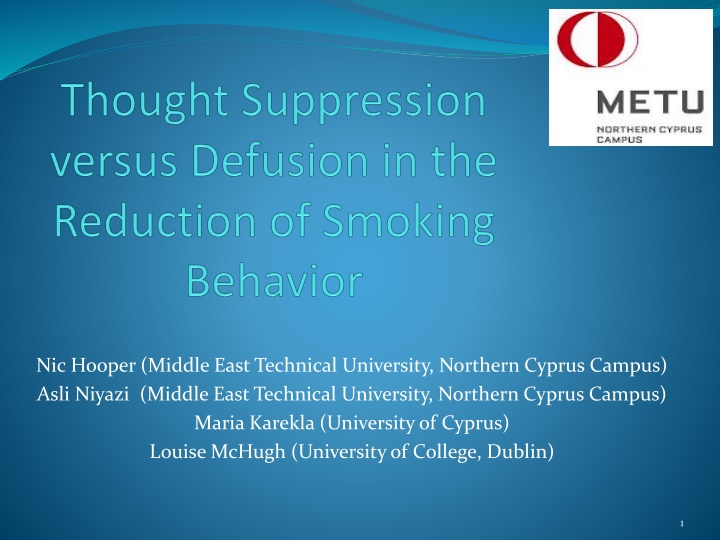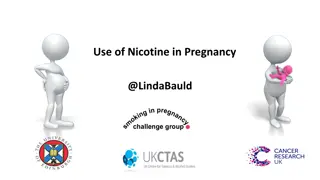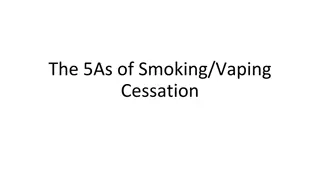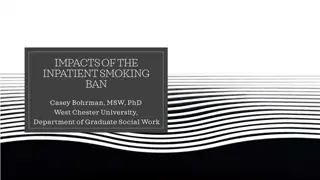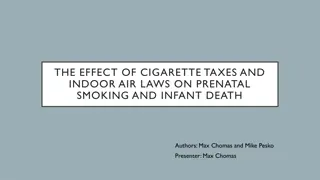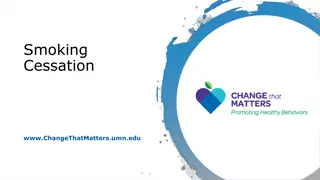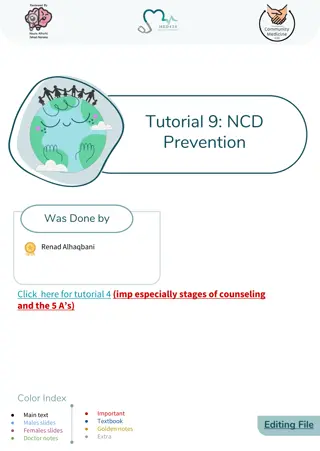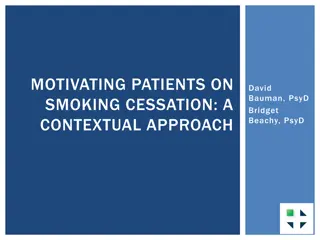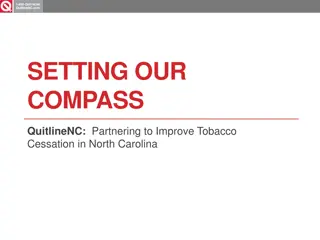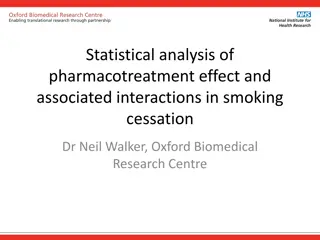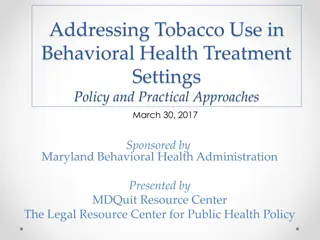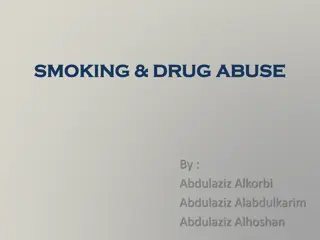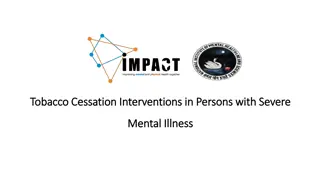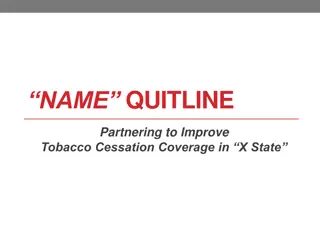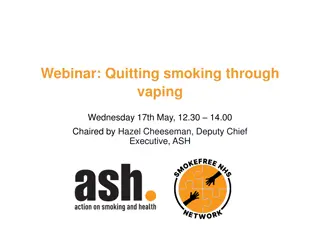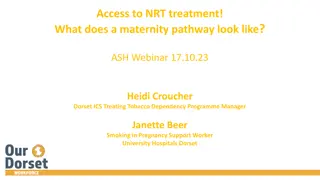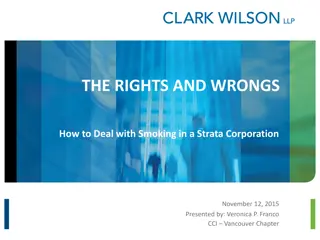Insights on Smoking Cessation Interventions and Thought Suppression Effects
Smoking is identified as a significant health risk globally, particularly among youth. This content discusses the challenges of smoking cessation interventions, such as thought suppression, and its impact on smoking behaviors, emphasizing the importance of understanding and applying effective strategies like Acceptance and Commitment Therapy (ACT).
Download Presentation

Please find below an Image/Link to download the presentation.
The content on the website is provided AS IS for your information and personal use only. It may not be sold, licensed, or shared on other websites without obtaining consent from the author.If you encounter any issues during the download, it is possible that the publisher has removed the file from their server.
You are allowed to download the files provided on this website for personal or commercial use, subject to the condition that they are used lawfully. All files are the property of their respective owners.
The content on the website is provided AS IS for your information and personal use only. It may not be sold, licensed, or shared on other websites without obtaining consent from the author.
E N D
Presentation Transcript
Nic Hooper (Middle East Technical University, Northern Cyprus Campus) Asli Niyazi (Middle East Technical University, Northern Cyprus Campus) Maria Karekla (University of Cyprus) Louise McHugh (University of College, Dublin) 1
Smoking is bad Smoking is an irreparable cause of diseases and early death and it is associated with numerous health problems, especially cancers (Centers for Disease Control and Prevention, 1997). Smoking has become a global scourge especially among youth (World Health Organization, 2008). Groups of youth, such as University students, present with higher smoking rates than ever before and extant interventions may not be as effective in achieving smoking cessation (Peters, Meshack, Kelder, Springer &Agurcia, 2011; Soteriades, Spanoudis, Talias, Warren, & DiFranza, 2011; Villanti, 2011; Wechsler, Rigotti, Gledhill-Hoyt& Lee, 1998). 2
Thought suppression is bad One popular way of managing unwanted thoughts is suppression (Wegner et al, 1987). However, much research suggests that trying to suppress an unwanted thought may increase the amount it intrudes. It may also cause a behavioral rebound effect Hooper, Stewart, Duffy, Freegard and McHugh (in press) Hooper, Davies, Davies and McHugh (2011) Hooper, Sandoz, Ashton, Clarke and McHugh (2012) 3
Using thought suppression to stop smoking is bad Erskine, Georgiou and Kvavilashvili (2010) divided participants into three groups; a suppression group, an expression group and a control group. During a three week period all participants were asked to monitor their smoking behavior. However in the second week the suppression group were asked to suppress all thoughts of smoking whilst the expression group were asked to think about smoking as much as possible. Results indicated that those participants asked to suppress their thoughts actually reduced their smoking behaviour during week 2. However, the notable result was the appearance of a behavioral rebound effect. Namely, in the final week in which all participants were simply asked to monitor their smoking behavior, the suppression group smoked significantly more cigarettes than the expression and control group. 4
ACT is good Investigations have been conducted which display that the full ACT package may be useful in the treatment of smoking cessation (Bricker et al, 2010; Gifford et al, 2004; Hernandez et al, 2009). However, it is important that we understand the processes that contribute to clinically relevant improvements in clients. For this reason, the investigation of each ACT component is crucial. A recent meta-analysis conducted by Levin, Hildebrandt, Lillis & Hayes (in press) investigating the utility of each ACT process indicated generous effect sizes. 5
Therapy is bad Another reason that the investigation of each component is important is because applying specific process based interventions takes less time than full-blown therapy. If brief and effective interventions can be developed then these could be administered to those in the general public who do not have the time or financial resources for Nicotine Replacement Therapy or full length Psychological Therapy. We feel that a brief defusion intervention could alter smoking behavior. 6
Defusion is good Defusion encourages clients to distance themselves from their thoughts, whilst helping them to understand that their thoughts do not have to be causal to their actions when they are not in the service of valued ends. Much research suggests that defusion may be worth investigating as an alternative to avoidance in the management of unwanted thoughts (De Young et al. 2010; Deacon et al., 2011; Healy et al., 2008; Hooper, Sandoz, Ashton, Clarke & McHugh, 2012; Hooper & McHugh, in press; Masuda et al., 2009; Masuda, et al., 2010; Masuda, Twohig, et al., 2010;). 7
The current study Participants recruited based on their desire to quit smoking, were asked to reduce and measure their smoking behavior for a one week period, via recording each cigarette they smoked, as they smoked it. In order to help participants reduce their smoking behavior they were given an intervention; thought suppression or defusion. They were also given a cue card reminder. As with Erskine et al (2010) we included a rebound week where all participants were relieved of the instruction to reduce cigarette consumption and were simply have to monitor and measure their smoking behavior. 8
Predictions Whereas a thought suppression intervention may cause an increase in unwanted thoughts with the possible side effect of increasing smoking behavior, a defusion instruction may allow participants to step away from their thoughts and control their actions. It was therefore expected that the defusion group would smoke significantly less cigarettes over week 1 and week 2 than the thought suppression group, who we expected to experience a behavioral rebound in week 2. 9
Method specifics As with Hernandez et al (2009) there were certain criteria that the participants had to meet in order to take part in the study. Participants had to a) have been smoking for at least 2 years b) smoke at least 10 cigarettes a day c) and be at least 18 years old. All participants were asked 4 treatment adherence questions. These showed that both groups used their intervention to a similar degree. However it is important to mention that neither group scored highly on these measures (Average 4.2 out of 7). 10
Control questions Defusion Thought suppression Years Smoking 7.46 6.43 Quit attempts 3.61 2.5 Motivation to quit 5.9 5.5 Average consumption 23.46 19.8 *covariate 11
Results Defusion Thought suppression Mean (SD) Mean (SD) Week 1 12.7 (8.7) 16.6 (10.5) Week 2 12.2 (10.2) 17.2 (8.6) Average consumption 23.4 (8.7) 19.8 (8.4) 12
Inferentials In week 1, there was a significant effect of condition on smoking behavior after controlling for average cigarette consumption. F (1,28) = 3.024, p < .05, 2 = .11 . These results indicate that the defusion group smoked significantly less than the thought suppression group in week 1. In week 2, there was also a significant effect of condition on smoking behavior after controlling for average cigarette consumption. F (1,28) = 4.044, p < .05, 2 = .14 . These results indicate that in week 2, where the participants were relieved of their instruction to reduce smoking behavior and simply left to monitor their cigarette consumption, the defusion group smoked significantly less than the thought suppression group. 13
Defusion is good Those participants exposed to a defusion intervention smoked significantly less than those who received a thought suppression intervention. In fact, over a 2 week period the defusion group reduced their cigarette intake by 153.3 cigarettes in comparison to their self-reported daily average. That adds up to nearly 8 boxes of cigarettes. Which in the United Kingdom s current economic climate, where a pack of cigarettes costs 7.46, adds up to a saving of nearly 60. 14
Thought suppression is.hmmmm It is important to note that those participants who received the thought suppression intervention also reduced their smoking behavior. Over the 2 week period they reduced their consumption by 40.6 cigarettes. Which is equivalent to two boxes of cigarettes and a saving of 14.92. 15
Thought suppression is. hmmmm The thought suppression group did not experience the expected behavioral rebound in week 2. From an ACT perspective, this result is not shocking. Thought suppression per se is not bad. It is possible that participants narrowed their behavioral repertoire, by for example avoiding social situations in which others were likely to be smoking. And it is this narrowing effect on behavior that may lead to psychological troubles. 16
Improvements are good There are a number of ways the research could be improved: Future research would benefit from a better measure of treatment adherence Believability measures A control group A post-experiment interview to note if participants avoided situations in order to control their smoking behavior 17
Take home message Smoking is bad We all knew that. Defusion is good A 5-10 minute defusion intervention allowed participants to control their behavior such that a significant reduction in smoking behavior was recorded. Thought suppression is .hmmm Participants in this group also reduced their smoking behavior. 18
